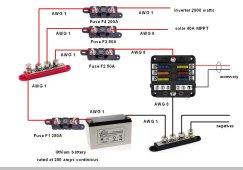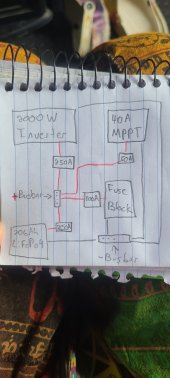LetMeHarnessTheSun
New Member
- Joined
- Apr 2, 2022
- Messages
- 5
Hey all, I'm building my first Solar setup and want to make sure I do it right. I'm setting up a system based on Will's 400W design. I'm looking at 360W solar panel, 2000W inverter, 206ah 12v lithium battery, and 40a MPPT. My question was regarding fuse, fuse block, and circuit breaker sizing.
So if I understand correctly,
2000/12= 166~ X 1.25 = 208~
So I would require a 250 amp circuit breaker on my main connection.
When I went and looked at the fuse box for DC appliances I notice it reads "Suitable main circuit connection of not more than 125A rating should be provided ahead of this device..." And the diagram shows a 125A fuse before the fuse block.
This is where my rudimentary knowledge of electricity comes in.
Am I going to fry my fuse block if there's no 125A fuse there, is it only dependant on the amount of power I intend to draw from the block (Will be used to charge phones, vent fan, lights, etc. Nowhere near 125A), or do I install a 125A fuse behind my 250A circuit breaker?
Sorry for what's likely a painfully basic question, I've gone mental figuring this all out, anything helps at this point.
So if I understand correctly,
2000/12= 166~ X 1.25 = 208~
So I would require a 250 amp circuit breaker on my main connection.
When I went and looked at the fuse box for DC appliances I notice it reads "Suitable main circuit connection of not more than 125A rating should be provided ahead of this device..." And the diagram shows a 125A fuse before the fuse block.
This is where my rudimentary knowledge of electricity comes in.
Am I going to fry my fuse block if there's no 125A fuse there, is it only dependant on the amount of power I intend to draw from the block (Will be used to charge phones, vent fan, lights, etc. Nowhere near 125A), or do I install a 125A fuse behind my 250A circuit breaker?
Sorry for what's likely a painfully basic question, I've gone mental figuring this all out, anything helps at this point.





